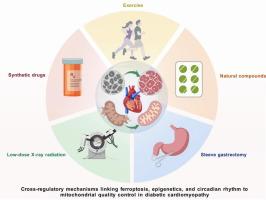Cross-regulatory mechanisms linking ferroptosis, epigenetics, and circadian rhythm to mitochondrial quality control in diabetic cardiomyopathy
IF 13
1区 综合性期刊
Q1 MULTIDISCIPLINARY SCIENCES
引用次数: 0
Abstract
Diabetic cardiomyopathy (DCM) is a distinct cardiac disorder that develops independently of coronary artery disease and hypertension. Mitochondrial dysfunction is widely recognized as a hallmark pathological feature of DCM. Effective mitochondrial quality control (MQC) is critical for preserving cardiomyocyte metabolism and contractile performance, and its disruption substantially contributes to both disease initiation and progression. We synthesize current evidence on disruptions of MQC in diabetic cardiomyopathy. The spectrum covers imbalanced fission–fusion dynamics, attenuated mitochondrial biogenesis, compromised mitophagy, disturbed Ca2+ homeostasis, heightened ferroptotic vulnerability, loss of proteostasis, and epigenetic dysregulation. We emphasize the intricate cross-talk among these processes, which collectively exacerbate mitochondrial deterioration and myocardial injury. Building on these mechanistic insights, we also summarize recent therapeutic advances targeting MQC, such as natural compounds, antidiabetic agents, and non-pharmacological approaches. These interventions show promise in modulating mitochondrial signaling and restoring homeostasis. Nevertheless, substantial barriers remain for clinical translation, including the limitations of existing experimental models, the low quality of supporting evidence, and pronounced inter-individual variability. Future research should focus on developing integrated, multi-target therapeutic strategies, particularly those addressing the regulatory roles of non-coding RNAs, epigenetic modifications, and post-translational protein regulation. Advancing these areas will be essential for establishing precise and effective MQC-targeted therapies in both preclinical and clinical contexts.

糖尿病心肌病中铁下垂、表观遗传学和昼夜节律与线粒体质量控制相关的交叉调节机制
糖尿病性心肌病(DCM)是一种独立于冠状动脉疾病和高血压发展的独特心脏疾病。线粒体功能障碍被广泛认为是DCM的一个标志性病理特征。有效的线粒体质量控制(MQC)对于保持心肌细胞代谢和收缩性能至关重要,其破坏在很大程度上有助于疾病的发生和进展。我们综合了糖尿病心肌病中MQC紊乱的现有证据。光谱包括不平衡的裂变融合动力学,线粒体生物发生减弱,线粒体自噬受损,Ca2+稳态紊乱,高铁易损性,蛋白质平衡丧失和表观遗传失调。我们强调这些过程之间错综复杂的串扰,共同加剧线粒体退化和心肌损伤。在这些机制的基础上,我们还总结了最近针对MQC的治疗进展,如天然化合物、抗糖尿病药物和非药物方法。这些干预在调节线粒体信号和恢复体内平衡方面显示出希望。然而,临床翻译仍然存在实质性障碍,包括现有实验模型的局限性、支持证据的低质量以及明显的个体间差异。未来的研究应侧重于开发综合的、多靶点的治疗策略,特别是那些解决非编码rna、表观遗传修饰和翻译后蛋白质调节作用的策略。推进这些领域对于在临床前和临床环境中建立精确和有效的mqc靶向治疗至关重要。
本文章由计算机程序翻译,如有差异,请以英文原文为准。
求助全文
约1分钟内获得全文
求助全文
来源期刊

Journal of Advanced Research
Multidisciplinary-Multidisciplinary
CiteScore
21.60
自引率
0.90%
发文量
280
审稿时长
12 weeks
期刊介绍:
Journal of Advanced Research (J. Adv. Res.) is an applied/natural sciences, peer-reviewed journal that focuses on interdisciplinary research. The journal aims to contribute to applied research and knowledge worldwide through the publication of original and high-quality research articles in the fields of Medicine, Pharmaceutical Sciences, Dentistry, Physical Therapy, Veterinary Medicine, and Basic and Biological Sciences.
The following abstracting and indexing services cover the Journal of Advanced Research: PubMed/Medline, Essential Science Indicators, Web of Science, Scopus, PubMed Central, PubMed, Science Citation Index Expanded, Directory of Open Access Journals (DOAJ), and INSPEC.
 求助内容:
求助内容: 应助结果提醒方式:
应助结果提醒方式:


